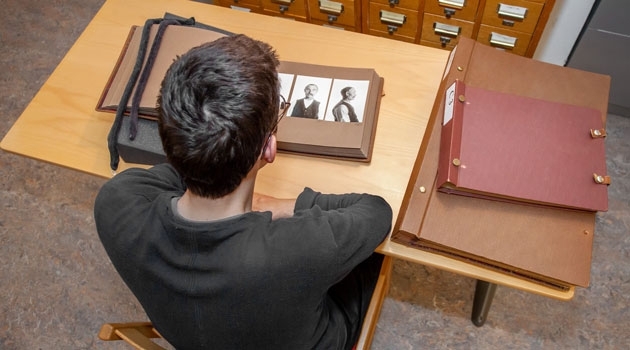Racial biology archive open for posterity
The archive from the Swedish State Institute for Racial Biology is still kept at Uppsala — in the University Library, Carolina Rediviva. The collections, including 105 photo albums with more than 12,000 images, are accessible for study and research.
The Institute for Racial Biology was set up following a decision by the Swedish Riksdag (Parliament) in 1921 and started its activities in Uppsala in 1922. Though independent, the organisation had ties with Uppsala University. When the Institute was closed and its research activities were transferred to the Department of Medical Genetics in 1959, Uppsala University was made responsible for the archive; and so it remains to this day. The archive has been housed in the University Library since the 1990s. The library holds hundreds of archives and other material that is only available for study in a reading room with special security arrangements. These holdings include the archive from the Institute for Racial Biology, which is among those for which there is most demand.
Parts of the archive are typical of a government agency: along with the correspondence, there are accounting records, minutes, collections of press clippings, individual books and publications. But some parts stand out from other archives and have aroused both interest and outrage: the 105 photo albums contain a total of more than 12,000 images of various ‘folk types’ collected at the Institute for Racial Biology.
Mounted in 105 photo albums
Some of the pictures were submitted by private individuals in connection with, for example, the Institute for Racial Biology’s exhibition “Kingdom of Svea” (Svea rike), which was part of the 1930 Stockholm Exhibition. The archive also contains a few pictures from the 1919 exhibition of Swedish ‘folk types’ for which Herman Lundborg collected material. This exhibition toured in Sweden and put forward racial biology ideas even before the Institute was established.
The photos taken by the Institute staff themselves or by photographers engaged by the Institute are mounted in 105 albums. Just over a third (some 38) may concern the Sami, according to the Institute’s categorisation. The albums have a variety of titles, such as “Lapps”, “Lapp mixed”, “Finnish”, “Walloons”, “Nurses”, “Twins”, “Triplets” and “The Workhouse in Landskrona”. The albums include one about Roma, one about Jews and a few about Swedes.
Inventory of the Swedish population
Photography was integral to the Institute’s working methods. Its staff were commissioned by the Government to compile an inventory of the Swedish population and, with presentations and lectures, popularise the ‘science’ of racial biology. They were also tasked with creating networks with researchers in other countries, including Germany, and with giving ten lectures at the University annually.
The purpose of racial biology was, by scientific means, to prevent ‘miscegenation’ (racial mixing), which was thought to result in ‘degeneration’. Preventing miscegenation would thus, it was believed, bring about an improvement in Swedish public health. The first director of the Institute for Racial Biology was Herman Lundborg, and it was during his time in office (1921–1935) that the photo albums were compiled. With Gunnar Dahlberg (director from 1935 to 1956) the hard line on racial biology ended. Dahlberg was anti-racist, anti-Nazi and more theoretically oriented than Lundborg.
Kept accessible
12,000 photos. Photo: Magnus Hjalmarsson
Over the years that the archive has been in Carolina Rediviva, Uppsala University Library has ensured that it was kept in order and made available to those wanting to access the material (as regulated in the Freedom of the Press Act, the Public Access to Information and Secrecy Act and the Archives Act). This means that anyone who needs to access the contents of the archive for any reason has a right to do so.
The Institute was a state authority and the documents drawn up or received by the Institute come under the principle of public access to official documents. There are no restrictions regarding access to the archive and its contents are therefore official documents. If the University prevents anyone from accessing the archive, an appeal may be lodged against this decision and a court case may ensue.
“Managing the archive is a complicated matter. There are many opinions about the photographic material in particular, both for and against. Sometimes social media posts and other comments about the material and its management are incorrect. For those of us responsible for making the archive available, it is very important that every question is answered and visitors are treated in a correct and responsible manner. Ultimately, though, the management of the archive is determined by legislation,” says Åsa Henningsson, Deputy Head of the Special Collections Division.
Annica Hulth

